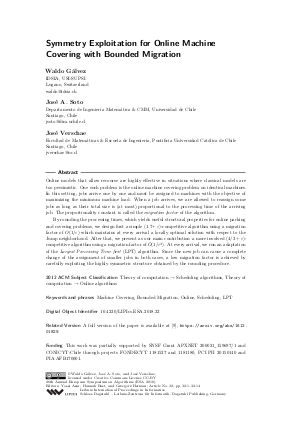Symmetry Exploitation for Online Machine Covering with Bounded Migration
Authors Waldo Gálvez, José A. Soto, José Verschae
-
Part of:
Volume:
26th Annual European Symposium on Algorithms (ESA 2018)
Part of: Series: Leibniz International Proceedings in Informatics (LIPIcs)
Part of: Conference: European Symposium on Algorithms (ESA) - License:
 Creative Commons Attribution 3.0 Unported license
Creative Commons Attribution 3.0 Unported license
- Publication Date: 2018-08-14
File

PDF
LIPIcs.ESA.2018.32.pdf
- Filesize: 497 kB
- 14 pages
Document Identifiers
Related Versions
Subject Classification
ACM Subject Classification
- Theory of computation → Scheduling algorithms
- Theory of computation → Online algorithms
Keywords
- Machine Covering
- Bounded Migration
- Online
- Scheduling
- LPT
Metrics
- Access Statistics
-
Total Accesses (updated on a weekly basis)
0Document
0Metadata
Abstract
Online models that allow recourse are highly effective in situations where classical models are too pessimistic. One such problem is the online machine covering problem on identical machines. In this setting, jobs arrive one by one and must be assigned to machines with the objective of maximizing the minimum machine load. When a job arrives, we are allowed to reassign some jobs as long as their total size is (at most) proportional to the processing time of the arriving job. The proportionality constant is called the migration factor of the algorithm. By rounding the processing times, which yields useful structural properties for online packing and covering problems, we design first a simple (1.7 + epsilon)-competitive algorithm using a migration factor of O(1/epsilon) which maintains at every arrival a locally optimal solution with respect to the Jump neighborhood. After that, we present as our main contribution a more involved (4/3+epsilon)-competitive algorithm using a migration factor of O~(1/epsilon^3). At every arrival, we run an adaptation of the Largest Processing Time first (LPT) algorithm. Since the new job can cause a complete change of the assignment of smaller jobs in both cases, a low migration factor is achieved by carefully exploiting the highly symmetric structure obtained by the rounding procedure.
Cite As Get BibTex
Waldo Gálvez, José A. Soto, and José Verschae. Symmetry Exploitation for Online Machine Covering with Bounded Migration. In 26th Annual European Symposium on Algorithms (ESA 2018). Leibniz International Proceedings in Informatics (LIPIcs), Volume 112, pp. 32:1-32:14, Schloss Dagstuhl – Leibniz-Zentrum für Informatik (2018)
https://doi.org/10.4230/LIPIcs.ESA.2018.32
BibTex
@InProceedings{galvez_et_al:LIPIcs.ESA.2018.32,
author = {G\'{a}lvez, Waldo and Soto, Jos\'{e} A. and Verschae, Jos\'{e}},
title = {{Symmetry Exploitation for Online Machine Covering with Bounded Migration}},
booktitle = {26th Annual European Symposium on Algorithms (ESA 2018)},
pages = {32:1--32:14},
series = {Leibniz International Proceedings in Informatics (LIPIcs)},
ISBN = {978-3-95977-081-1},
ISSN = {1868-8969},
year = {2018},
volume = {112},
editor = {Azar, Yossi and Bast, Hannah and Herman, Grzegorz},
publisher = {Schloss Dagstuhl -- Leibniz-Zentrum f{\"u}r Informatik},
address = {Dagstuhl, Germany},
URL = {https://drops.dagstuhl.de/entities/document/10.4230/LIPIcs.ESA.2018.32},
URN = {urn:nbn:de:0030-drops-94959},
doi = {10.4230/LIPIcs.ESA.2018.32},
annote = {Keywords: Machine Covering, Bounded Migration, Online, Scheduling, LPT}
}
Author Details
Funding
This work was partially supported by SNSF Grant APXNET 200021_159697/1 and CONICYT-Chile through projects FONDECYT 1181527 and 1181180, PCI PII 20150140 and PIA AFB170001.
References
-
Y. Azar and L. Epstein. On-line machine covering. J. Sched., 1:67-77, 1998.

-
S. Berndt, K. Jansen, and K. Klein. Fully dynamic bin packing revisited. In APPROX/RANDOM 2015, pages 135-151, 2015.

-
Xujin Chen, Leah Epstein, Elena Kleiman, and Rob van Stee. Maximizing the minimum load: The cost of selfishness. Theor. Comput. Sci., 482:9-19, 2013.

-
J. Csirik, H. Kellerer, and G. Woeginger. The exact LPT-bound for maximizing the minimum completion time. Oper. Res. Lett., 11:281-287, 1992.

-
B. Deuermeyer, D. Friesen, and M. Langston. Scheduling to maximize the minimum processor finish time in a multiprocessor system. SIJADM, 3:190-196, 1982.

-
L. Epstein and A. Levin. A robust APTAS for the classical bin packing problem. Math. Program., 119:33-49, 2009.

-
L. Epstein and A. Levin. Robust algorithms for preemptive scheduling. Algorithmica, 69:26-57, 2014.

-
A. Frangioni, E. Necciari, and M. Scutellà. A multi-exchange neighborhood for minimum makespan parallel machine scheduling problems. J. Comb. Optim., 8:195-220, 2004.

- Waldo Gálvez, José A. Soto, and José Verschae. Symmetry exploitation for online machine covering with bounded migration. CoRR, 2016. URL: http://arxiv.org/abs/1612.01829.
-
A. Gu, A. Gupta, and A. Kumar. The power of deferral: Maintaining a constant-competitive steiner tree online. SIAM J. Comput., 45:1-28, 2016.

-
D. Hochbaum and D. Shmoys. A polynomial approximation scheme for scheduling on uniform processors: Using the dual approximation approach. SIAM J. Comput., 17:539-551, 1988.

-
K. Jansen and K. Klein. A robust AFPTAS for online bin packing with polynomial migration. In ICALP 2013, pages 589-600, 2013.

-
K. Jansen, K. Klein, and J. Verschae. Closing the gap for makespan scheduling via sparsification techniques. In ICALP 2016, pages 1-13, 2016.

-
J. \Lacki, J. Oćwieja, M. Pilipczuk, P. Sankowski, and A. Zych. The power of dynamic distance oracles: Efficient dynamic algorithms for the steiner tree. In STOC 2015, pages 11-20, 2015.

-
N. Megow, M. Skutella, J. Verschae, and A. Wiese. The power of recourse for online MST and TSP. SIAM J. Comput., 45:859-880, 2016.

-
D. Recalde, C. Rutten, P. Schuurman, and T. Vredeveld. Local Search Performance Guarantees for Restricted Related Parallel Machine Scheduling. LATIN 2010, pages 108-119, 2010.

-
P. Sanders, N. Sivadasan, and M. Skutella. Online scheduling with bounded migration. Math. Oper. Res., 34:481-498, 2009.

-
P. Schuurman and T. Vredeveld. Performance guarantees of local search for multiprocessor scheduling. INFORMS J. Comput., 19:52-63, 2007.

-
M. Skutella and J. Verschae. Robust polynomial-time approximation schemes for parallel machine scheduling with job arrivals and departures. Math. Oper. Res., 41:991-1021, 2016.

-
B. Vöcking. Selfish load balancing. In Algorithmic Game Theory, pages 517-542. Cambridge University Press, 2007.

-
G. Woeginger. A polynomial-time approximation scheme for maximizing the minimum machine completion time. Oper. Res. Lett., 20:149-154, 1997.

